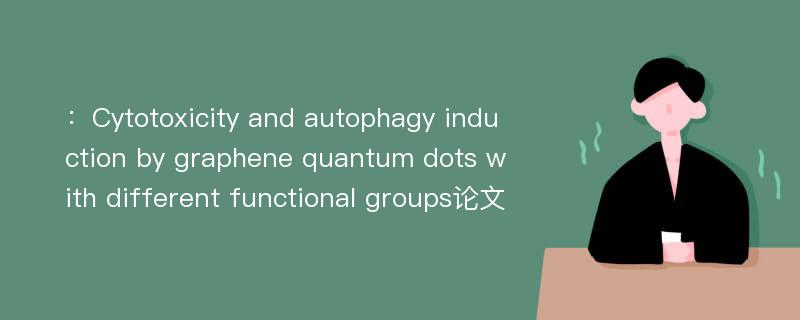
本文主要研究内容
作者(2019)在《Cytotoxicity and autophagy induction by graphene quantum dots with different functional groups》一文中研究指出:Graphene quantum dots(GQDs) possess great potential in various applications due to their superior physicochemical properties and wide array of available surface modifications.However, the toxicity of GQDs has not been systematically assessed, thus hindered their further development; especially, the risk of surface modifications of GQDs is largely unknown. In this study, we employed a lung carcinoma A549 cells as the model to investigate the cytotoxicity and autophagy induction of three types GQDs, including cGQDs(COOH-GQDs), hGQDs(OH-GQDs), and aGQDs(NH2-GQDs). The results showed hGQDs was the most toxic, as significant cell death was induced at the concentration of 100 μg/mL,determining by WST-1 assay as well as Annexin-V-FITC/PI apoptosis analysis, whereas cGQDs and aGQDs were non-cytotoxic within the measured concentration. Autophagy detection was performed by TEM examination, LC3 fluorescence tracking, and Westernblot. Both aGQDs and hGQDs induced cellular autophagy to various degrees except for cGQDs. Further analysis on autophagy pathways indicated all GQDs significantly activated p-p38 MAPK; p-ERK1/2 was inhibited by aGQDs and hGQDs but activated by c GQDs. p-JNK was inhibited by aGQDs and c GQDs, while activated by hGQDs. Simultaneously, Akt was activated by hGQDs but inhibited by aGQDs. Inhibition of autophagy by 3-MA significantly increased the cytotoxicity of GQDs, suggesting that autophagy played a protective role against the toxicity of GQDs. In conclusion, c GQDs showed excellent biocompatibility and may be considered for biological applications. Autophagy induction may be included in the health risk assessment of GQDs as it reflects the stress status which may eventually lead to diseases.
Abstract
Graphene quantum dots(GQDs) possess great potential in various applications due to their superior physicochemical properties and wide array of available surface modifications.However, the toxicity of GQDs has not been systematically assessed, thus hindered their further development; especially, the risk of surface modifications of GQDs is largely unknown. In this study, we employed a lung carcinoma A549 cells as the model to investigate the cytotoxicity and autophagy induction of three types GQDs, including cGQDs(COOH-GQDs), hGQDs(OH-GQDs), and aGQDs(NH2-GQDs). The results showed hGQDs was the most toxic, as significant cell death was induced at the concentration of 100 μg/mL,determining by WST-1 assay as well as Annexin-V-FITC/PI apoptosis analysis, whereas cGQDs and aGQDs were non-cytotoxic within the measured concentration. Autophagy detection was performed by TEM examination, LC3 fluorescence tracking, and Westernblot. Both aGQDs and hGQDs induced cellular autophagy to various degrees except for cGQDs. Further analysis on autophagy pathways indicated all GQDs significantly activated p-p38 MAPK; p-ERK1/2 was inhibited by aGQDs and hGQDs but activated by c GQDs. p-JNK was inhibited by aGQDs and c GQDs, while activated by hGQDs. Simultaneously, Akt was activated by hGQDs but inhibited by aGQDs. Inhibition of autophagy by 3-MA significantly increased the cytotoxicity of GQDs, suggesting that autophagy played a protective role against the toxicity of GQDs. In conclusion, c GQDs showed excellent biocompatibility and may be considered for biological applications. Autophagy induction may be included in the health risk assessment of GQDs as it reflects the stress status which may eventually lead to diseases.
论文参考文献
论文详细介绍
论文作者分别是来自Journal of Environmental Sciences的,发表于刊物Journal of Environmental Sciences2019年03期论文,是一篇关于,Journal of Environmental Sciences2019年03期论文的文章。本文可供学术参考使用,各位学者可以免费参考阅读下载,文章观点不代表本站观点,资料来自Journal of Environmental Sciences2019年03期论文网站,若本站收录的文献无意侵犯了您的著作版权,请联系我们删除。
